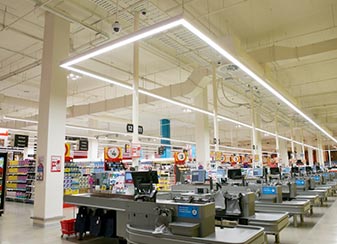Supermarket lighting has undergone a radical change. Gone are the days of traditional HID, fluorescent and incandescent lighting. LED lighting has revolutionized the lighting industry and is growing in popularity for its benefits beyond appearance. LEDs save energy, reduce maintenance costs, and perform much better than traditional fluorescent lighting. Here are some of the reasons why supermarkets are upgrading their lighting
Not all fruits and vegetables in the produce section are created equal. Even if all your produce is fresh, colorful-looking things like apples will always be first in line. LED lights can help reduce waste by making all products look fresh. It's like this.
Color rendering index (also known as CRI) is a measure of how accurately a light source displays color. It is on a scale of 1 to 100, where 100 is The higher the CRI value, the more accurate the artificial light will be in displaying color.
Supermarket Lighting
LED bulbs have a standard color rendering index of 90+ but can reach up to 95+ CRI. There are also specialty LED products designed for key high-margin areas of supermarkets (produce and meat) to further improve product marketability. This means produce looks as fresh on your shelves as it does on the farm, and the meat looks so delicious that shoppers will look forward to their next barbecue. That makes LED lighting the perfect choice for supermarket lighting!
Have you ever touched a light bulb that was turned off and it was still hot? Now, imagine placing the light next to cold food for a long time. It can raise the temperature of the food and affect its freshness. In addition, the heat of the bulb can use more energy to balance the heat of the lamp.
LED lighting works differently than traditional light bulbs. Because they operate so efficiently, they produce a fraction of the heat of incandescent, HID, and fluorescent sources. This means your cold food won't be damaged by the unnecessary heat it's subjected to, and you'll save on stored energy.
The filament that glows in an incandescent lamp can reach temperatures up to 4600 °F (2500 °C), while the glass bulb around it reaches temperatures around 392-500 °F (200-260 °C) due to the heat it emits. The operating temperature of the LED is between 68-140 °F ( 20-80 °C). Now that's a huge temperature difference.

Supermarket Lighting
Supermarkets are open longer than many other retail stores. They are open on average more than 14 hours a day. And, most importantly, most grocery stores employ night shift workers to stock their inventory during off-hours. Many grocery store lights are working around the clock.
While traditional lighting has a lifespan of 5,000 hours, LED lights can last more than 50,000 hours. That's 10 times longer than outdated supermarket lighting. For supermarkets with LED lighting, this means reduced maintenance and replacement costs for the installation alone. Energy cost savings are 60-75% less than traditional lighting.
Just as you keep up with current food trends, so should your grocery store. LED lighting helps make grocery stores bright, efficient, crisp, and well-displayed. Need help with supermarket lighting? Contact Powerstar today to see how we can help you brighten up your supermarket!
Copyright © Shenzhen Powerstar Technology Co., Ltd. All Rights Reserved. | Sitemap | Powered by 